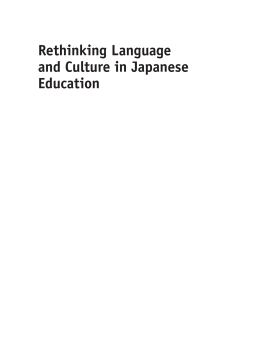
Additional Information
Book Details
Abstract
How does language or culture come to be standardized to the degree that it is considered 'homogeneous'? How does teaching language relate to such standardization processes? How can teaching be mindful of the standardization processes that potentially involve power relations? Focusing on the case of Japanese, which is often viewed as homogenous in terms of language and culture, this volume explores these questions in a wide range of contexts: the notions of translation and modernity, the ideologies of the standardization of regional dialects in Japan, current practices in college Japanese-as-a- Foreign-Language classrooms in the United States, discourses in journals of Japanese language education, and classroom practices in nursery and primary schools in Japan. This volume’s investigation of standardization processes of Japanese language and culture addresses the intersections of theoretical and practical concerns of researchers and educators that are often overlooked.
This is a fascinating original study of the politics involved in standardizing Japanese language. It is the first to jointly examine Japanese language education for 'native' speakers (kokugo) and for 'non-native' speakers. Its interdisciplinary approach makes the book enlightening for anyone interested in language, education, or Japanese society.
Shinji Sato is Senior Lecturer and Director of the Japanese Language Program, Department of East Asian Studies, Princeton University, USA. His research interests include language policy and teaching and the critical examination of commonplace ideas in language education.
Neriko Musha Doerr teaches at Salameno School of American and International Studies, Ramapo College of New Jersey, USA. Her research interests include bilingual and heritage language education and the anthropology of education.
A must-read book for Japanese and other language educators. This book makes language educators, myself included, face the nature of our profession, which, whether we like it or not, cannot escape from being involved in ideologies and politics. The book asks us to examine our accountability as intermediaries between the 'language' and learners, who regularly (and often without much thought) make choices about the 'language' for the learners.
Table of Contents
| Section Title | Page | Action | Price |
|---|---|---|---|
| Contents | v | ||
| Contributors | vii | ||
| Introduction | 1 | ||
| Part 1 Theoretical Framework | 17 | ||
| 1 Standardization of Language and Culture | 19 | ||
| 2 Language as a Countable and the Regime of Translation | 35 | ||
| Part 2 Kokugo Education: Japanese Education Designed for ‘Native Speakers’ | 61 | ||
| 3 On the Necessity of ‘Being Understood’: Rethinking the Ideology of Standardization in Japan | 63 | ||
| 4 Rethinking ‘Norms’ for Japanese Women’s Speech | 82 | ||
| 5 Constructing and Constructed Japanese: The History of Standard Japanese and Practice at a Japanese Preschool | 106 | ||
| 6 How Japanese Education for Young People Has Been Discussed: A Critical Analysis from a Relational Viewpoint | 128 | ||
| 7 A Consideration of the Discourse on Mother Tongue Instruction in Japanese Language Education: A Case Study of the Practices of Japanese Language Classes for Chinese Returnees and Vietnamese Residents | 143 | ||
| Part 3 Nihongo Education: Japanese Education Designed for ‘Non-Native Speakers’ | 173 | ||
| 8 Teaching Japanese People’s Thinking: Discourses on Thought Patterns in Post-war Studies of Japanese Language Education | 175 | ||
| 9 On Learning Japanese Language: Critical Reading of Japanese Language Textbook | 201 | ||
| 10 Critical Teaching of Japanese Culture | 218 | ||
| 11 The Process of Standardization of Language and Culture in a Japanese-as-a-Foreign-Language Classroom: Analysis of Teacher–Students Interactions | 238 | ||
| Conclusion and Departure | 261 | ||
| Index | 267 |
